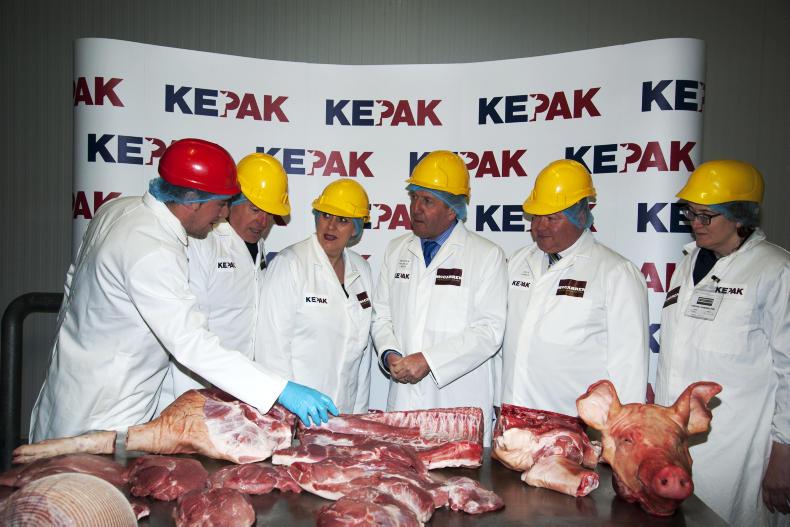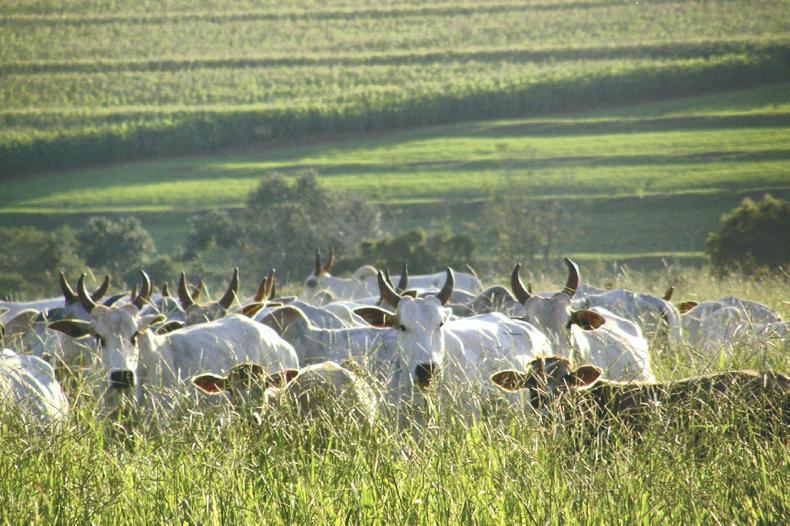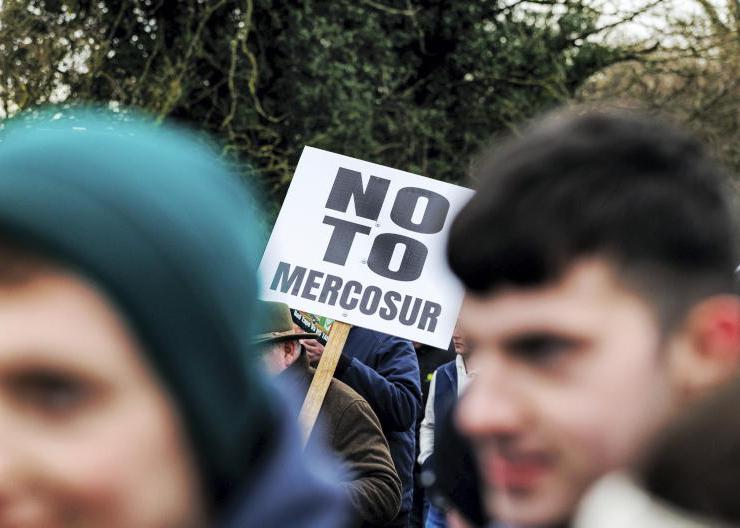While the threat of Brexit looms large on the horizon for Ireland’s meat industry, it should be remembered that it’s not so many years ago since processors in this country were deboning beef into boxes, freezing it and shipping it to the Middle East or selling it into EU intervention.
In the intervening years, Ireland’s meat industry has come a long way in terms of processing sophistication, new market development and supply chain traceability.
For Sean Coffey, chief executive of Kepak’s Meat Division, this is a sign that the industry can survive the considerable challenges facing the sector, including Brexit.

While the trading relationship between the UK and the EU is far from clear at this stage, Coffey is confident the UK will always be an important trading partner for Ireland’s meat industry.
“I believe the UK will still be a significant market post-Brexit. How significant time will tell,” says Coffey.
“Ireland’s food industry has coped with lots of challenges and we’re a resilient bunch. We might have some short-term pain but we will develop alternative markets. There is no doubt about it,” he added.
Real inflation
Trading relationships aside, the biggest challenge in the UK market over the last two years has been the volatility in sterling. With the currency falling to lows of £0.93 against the euro this year, Ireland’s competitiveness has been severely eroded.
Despite this headwind, Irish beef exports to the UK for the first eight months of 2017 are 4% ahead of last year at more than 172,000t. Coffey says there are a number of factors behind this including a latent demand for high-quality beef, an established route to market and the reputation of Irish beef in terms of safety and traceability.
However, while volumes have increased, the price of beef on the UK retail shelf has not increased. Coffey says there is no real price inflation in the UK grocery retail sector for meat, particularly beef.
“The market conditions in the UK retail sector will not allow for price increases for meat products. The UK economy is not growing and it’s becoming more and more competitive at retail level,” he says.
“Most of the supermarkets have stated publicly that their recovery will be volume-led. They need more people through their doors and they won’t achieve that through price inflation.”
This is the real conundrum facing the meat industry right now.
There is no doubt China will add value to the fifth quarter
With exchange rates working against Irish meat exporters, there is zero appetite among UK retailers to pass on the decline in sterling to consumers in the form of higher meat prices for fear of losing market share. This standoff is the major challenge facing the industry and the main reason Coffey says Kepak are under real pressure right now.
“We’re really feeling the pinch right now. The retailers are absorbing some of that (currency) cost and we’re taking some of the cost. Where the ratios sit I’m not sure but we’re under pressure price-wise,” says Coffey.

Right now, supermarkets are busy planning their Christmas meat orders with suppliers but Coffey says there’s definitely less of an appetite than previous years.
Supermarkets have sent definite signals back down the supply chain that they are less able to invest in prices.
Promotions on meat this Christmas will not be as deep-cut or long-running as previous years as a result.
Less promotion will have the effect of reducing beef sales volumes.
For many farmers, the US has been a disappointing market since Ireland gained access, with just 962t exported in the first eight months of 2017. However, Coffey is firm in that the US remains a long-term play.
“I think you need to be patient. I don’t think it was a case of the doors opening and US consumers would be waiting to rip product off our hands. It’s like any market. You’ve got to invest in it, understand the consumer and their needs and service those,” he says.

With the large ex-pat Irish community on the east coast of the US in cities like Boston and New York in mind, Kepak has partnered with a local beef company in the US to contract-manufacture and package beef for them.
Tageting high value markets
In September, Kepak launched the Celtic Beef Company brand in the Boston region by partnering with Roche Bros supermarket chain.
Coffey says the brand has received a “phenomenal reaction” since launching but it is clear that establishing this brand properly will take time and a sustained investment.
In China, Kepak has a team of six working from an office in Shanghai. Coffey says the role of this team is to try and understand the opportunity for Irish beef in China.
“There is no doubt China will add value to the fifth quarter but we’re hoping it will add value to prime beef too,” said Coffey.
One of the successes for Irish beef exports in the first half of 2017 has been the surging demand from the Philippines, a market Ireland has had access to since 2014.
From January to June this year, Irish beef shipments to the Philippines were just under 11,000t, which was a 150% increase on the same period last year.
Irish beef exports to the Philippines had benefited due to a lack of supply from Australia, which is the traditional beef supply base for Philippine importers.
However, Coffey said that Kepak was already seeing a slowdown in demand as Australian cattle numbers recovered.
“Australia is coming back with a vengeance and we’re seeing them reinvest a lot in the market. While their full supply is not on stream they are prepared to invest in price and win back market share in the Philippines,” said Coffey.
In 2017, the Irish price of 70% lean beef (manufacturing) is almost double what it was in 2016. In contrast, Australia’s beef price is much cheaper than Ireland.
“As a country and an organisation we are still doing significant volumes into the Philippines but not as much as we recently have done,” he added.
This is illustrated in export figures from the CSO which show that demand for Irish beef from the Philippines for July and August was up 30% year on year. This is a sharp slowdown compared to the growth rate of 150% seen in the first half of 2017.

Sean Coffey.
Processing 260,000 head, or 15% of the national kill every year, Kepak is the third-largest player in the Irish beef industry. While Irish beef prices have declined since August, Coffey is steadfast that the Irish beef industry has performed well in recent years.
“If you look at the beef market over a number of years, Ireland has gone from paying the second-lowest prices for livestock in the EU to paying the second-highest prices behind the UK.
"We’re just below the UK price and we’ve sustained that. So I think that demonstrates a good track record. If you look at it over an extended period, we’ve outperformed,” he says.
Irish prices
With an extra 100,000 cattle in the system this year, Coffey says the Irish beef industry has been able to process the extra numbers, find markets for the product and, for the large part, maintained prices.
Over the last month, beef prices in countries like Italy have been around the €4/kg mark and above the Irish price.
However, Coffey maintains this price in Italy is for a finite volume of cattle as the underlying beef market in Italy is under downward pressure from the very high volume of young bulls being imported from France.
Read more
More on Kepak
While the threat of Brexit looms large on the horizon for Ireland’s meat industry, it should be remembered that it’s not so many years ago since processors in this country were deboning beef into boxes, freezing it and shipping it to the Middle East or selling it into EU intervention.
In the intervening years, Ireland’s meat industry has come a long way in terms of processing sophistication, new market development and supply chain traceability.
For Sean Coffey, chief executive of Kepak’s Meat Division, this is a sign that the industry can survive the considerable challenges facing the sector, including Brexit.

While the trading relationship between the UK and the EU is far from clear at this stage, Coffey is confident the UK will always be an important trading partner for Ireland’s meat industry.
“I believe the UK will still be a significant market post-Brexit. How significant time will tell,” says Coffey.
“Ireland’s food industry has coped with lots of challenges and we’re a resilient bunch. We might have some short-term pain but we will develop alternative markets. There is no doubt about it,” he added.
Real inflation
Trading relationships aside, the biggest challenge in the UK market over the last two years has been the volatility in sterling. With the currency falling to lows of £0.93 against the euro this year, Ireland’s competitiveness has been severely eroded.
Despite this headwind, Irish beef exports to the UK for the first eight months of 2017 are 4% ahead of last year at more than 172,000t. Coffey says there are a number of factors behind this including a latent demand for high-quality beef, an established route to market and the reputation of Irish beef in terms of safety and traceability.
However, while volumes have increased, the price of beef on the UK retail shelf has not increased. Coffey says there is no real price inflation in the UK grocery retail sector for meat, particularly beef.
“The market conditions in the UK retail sector will not allow for price increases for meat products. The UK economy is not growing and it’s becoming more and more competitive at retail level,” he says.
“Most of the supermarkets have stated publicly that their recovery will be volume-led. They need more people through their doors and they won’t achieve that through price inflation.”
This is the real conundrum facing the meat industry right now.
There is no doubt China will add value to the fifth quarter
With exchange rates working against Irish meat exporters, there is zero appetite among UK retailers to pass on the decline in sterling to consumers in the form of higher meat prices for fear of losing market share. This standoff is the major challenge facing the industry and the main reason Coffey says Kepak are under real pressure right now.
“We’re really feeling the pinch right now. The retailers are absorbing some of that (currency) cost and we’re taking some of the cost. Where the ratios sit I’m not sure but we’re under pressure price-wise,” says Coffey.

Right now, supermarkets are busy planning their Christmas meat orders with suppliers but Coffey says there’s definitely less of an appetite than previous years.
Supermarkets have sent definite signals back down the supply chain that they are less able to invest in prices.
Promotions on meat this Christmas will not be as deep-cut or long-running as previous years as a result.
Less promotion will have the effect of reducing beef sales volumes.
For many farmers, the US has been a disappointing market since Ireland gained access, with just 962t exported in the first eight months of 2017. However, Coffey is firm in that the US remains a long-term play.
“I think you need to be patient. I don’t think it was a case of the doors opening and US consumers would be waiting to rip product off our hands. It’s like any market. You’ve got to invest in it, understand the consumer and their needs and service those,” he says.

With the large ex-pat Irish community on the east coast of the US in cities like Boston and New York in mind, Kepak has partnered with a local beef company in the US to contract-manufacture and package beef for them.
Tageting high value markets
In September, Kepak launched the Celtic Beef Company brand in the Boston region by partnering with Roche Bros supermarket chain.
Coffey says the brand has received a “phenomenal reaction” since launching but it is clear that establishing this brand properly will take time and a sustained investment.
In China, Kepak has a team of six working from an office in Shanghai. Coffey says the role of this team is to try and understand the opportunity for Irish beef in China.
“There is no doubt China will add value to the fifth quarter but we’re hoping it will add value to prime beef too,” said Coffey.
One of the successes for Irish beef exports in the first half of 2017 has been the surging demand from the Philippines, a market Ireland has had access to since 2014.
From January to June this year, Irish beef shipments to the Philippines were just under 11,000t, which was a 150% increase on the same period last year.
Irish beef exports to the Philippines had benefited due to a lack of supply from Australia, which is the traditional beef supply base for Philippine importers.
However, Coffey said that Kepak was already seeing a slowdown in demand as Australian cattle numbers recovered.
“Australia is coming back with a vengeance and we’re seeing them reinvest a lot in the market. While their full supply is not on stream they are prepared to invest in price and win back market share in the Philippines,” said Coffey.
In 2017, the Irish price of 70% lean beef (manufacturing) is almost double what it was in 2016. In contrast, Australia’s beef price is much cheaper than Ireland.
“As a country and an organisation we are still doing significant volumes into the Philippines but not as much as we recently have done,” he added.
This is illustrated in export figures from the CSO which show that demand for Irish beef from the Philippines for July and August was up 30% year on year. This is a sharp slowdown compared to the growth rate of 150% seen in the first half of 2017.

Sean Coffey.
Processing 260,000 head, or 15% of the national kill every year, Kepak is the third-largest player in the Irish beef industry. While Irish beef prices have declined since August, Coffey is steadfast that the Irish beef industry has performed well in recent years.
“If you look at the beef market over a number of years, Ireland has gone from paying the second-lowest prices for livestock in the EU to paying the second-highest prices behind the UK.
"We’re just below the UK price and we’ve sustained that. So I think that demonstrates a good track record. If you look at it over an extended period, we’ve outperformed,” he says.
Irish prices
With an extra 100,000 cattle in the system this year, Coffey says the Irish beef industry has been able to process the extra numbers, find markets for the product and, for the large part, maintained prices.
Over the last month, beef prices in countries like Italy have been around the €4/kg mark and above the Irish price.
However, Coffey maintains this price in Italy is for a finite volume of cattle as the underlying beef market in Italy is under downward pressure from the very high volume of young bulls being imported from France.
Read more
More on Kepak

















SHARING OPTIONS